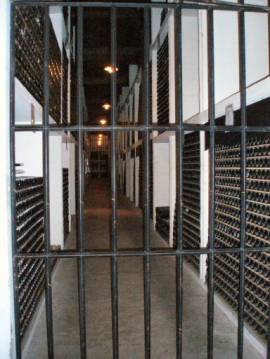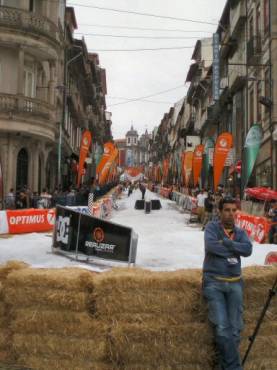The sights and tastes of Porto

|
11 - 12 May 2007: Porto There isn’t much to see or do in Povoa de Varzim, but the main reason for our long stay there was its proximity to Porto and my sister’s visit. There is a marina closer to Porto but we had been warned off it by a person we met who was heading North. The marina in Povoa was sheltered, friendly and most importantly cheap, and the town had a newly open metro which meant it was only an hour from Porto. We had two fun days seeing the sights of Porto, spending one day north of the river, and one day on the south bank. There is plenty to do and see on the north side, and it was a long slog trying to cram it all into a day (oh but Amelia is ever so determined in these things…J). Most of the things to see were churches, but it was interesting strolling through the old town and admiring the painted tiles on most of the buildings. The main train station had the best tile painting in Porto, which covered the whole of the entrance hall (20,000 tiles in total! imagine replacing the grout in them!).
Tile Painting in Sao Bento Train Station Porto is built on a steep hill, so everywhere we went seemed to be uphill. We added to this thigh-and-bum workout by climbing the 200-odd stairs of the Torre dos Clerigos, where we had stunning views across the city. It was interesting to look across to the south side of the river and see all the Port houses advertising their location with big Hollywood style signs. The tower also had a bell-ringing organ, which I had never seen before. It looked very complicated to play, especially when pushing the pedal for the biggest bell.
Torre dos Clerigos and the Bell Organ Another uphill climb brought us to the Se, Porto’s
cathedral. The church itself is a
not very interesting muddle of different architecture, but the cloisters were
worth a visit. There we saw more
pretty blue and white tile paintings, and an interesting exhibition of religious
art in the Chapterhouse (including some angels that looked like they were
doing the ‘Matelot Shuffle’…J).
The Se Cloisters The most extravagant and gory place we visited was the Igreja de Sao Francisco. The church was originally built in the 14th century, but the interior was completely transformed in the 18th century thanks to donations from Porto’s rich merchant families. There was gold everywhere, and it was overwhelming in comparison to the gloom of the other churches we visited. Below the church were the catacombs where the rich were buried – a little window allows visitors to see the thousands of human bones laid below, cleaned and stored to await judgement day. Eleanor and I got out quick, especially when one of the access doors to the tomb below creaked spookily under my feet! Porto is, after all, most famous for Port wine (like Champagne, Port must come from the Douro region in Portugal), so we returned to Porto the following day especially to visit the Port houses in Vila Nova de Gaia, on the south side of the river. Having been told that we can just turn up and join a tour of the big Port houses we were disappointed to find that both Calem and Sanderman were fully booked for the day. We wandered along the river at a bit of a loss, and stopped to read a sign outside a small, unknown Port house. A little Portuguese man quickly jumped out to greet us, and ushered us inside for a tour. He then rushed off to find their English speaking guide. It was a marked contrast to the clinical corporate welcome we had in the big Port houses, where a pretty receptionist in a uniform (nothing wrong with that per se…J) put your name down on a list. We had a brilliant, informative and interesting tour of the Vasconcellos Port house, from a very friendly man who was happy to be interrupted and answered all our (Amelia’s) questions. He talked us through the Port making process, and explained the different types of Port. He was quite snooty about some of the types of Port, explaining that the worse stuff generally ends up in supermarket own brand bottles.
Barrels of Port
The different colours of Port When the tour was over it was time for the Port tasting. The guide gave us a bit of a Ruby, Tawny and Special Reserve to try. He gave James and I a glass to share, but as Eleanor was on her own, she got a glass to herself. This meant she had to down each glass when it was time to taste the next flavour! Having drunk a lot of Port during my naval career (perks of the job!), I have to say I never noticed the difference between the types before. Drinking one type after another really showed how the older port was much more tasty. We were also given the opportunity to buy a glass of 20-year-old and 30-year-old Port, which we promptly took up. It was delicious. By this stage we were truly shozzled, and all the promises we made of not being taken in by the tourist trap of buying expensive Port in the Port house went out of the window. We convinced ourselves that it was a good deal, and relieved the Port house of several of their prized bottles of Port.
Post Port Wine Tasting Drunkenness… We realised that it was a good wheeze visiting the Port houses and having some free Port. So we decided to do another tour, just so that we could compare Port makers, of course! We marched up the hill to Crofts, and joined an English speaking tour part of the way through. A pretty little guide showed us around the vast Croft warehouse, where hundreds of barrels of Port were maturing. There was a special section devoted to the wine owned by the family, which had a sample batch from each Vintage year. There were only 3 bottles of the 1854 Vintage Port left, and we wondered who would have the guts to open them and deprive future generations of the special stuff. The tour was much more clinical than the previous one, with the guide giving a memorized speech and getting flustered by questions. The Port tasting consisted of a small measure of the Crofts Ruby Port, with no explanation or discussion. It was disappointing, but it made our “exclusive” tour at Vasconcellos all the better.
Crofts Port House On the way back to the metro station we really felt that we had too much Port when we saw snow in the middle of one of the streets in Porto. It turned out to be the World’s first Urban Slalom competition! They had built a piste on one of the steep streets, made snow overnight, and then put ski jumps and flags along the way. By the time we got there at the end of the day there wasn’t much snow left, but it was still surreal!
Snow in Porto in May |












